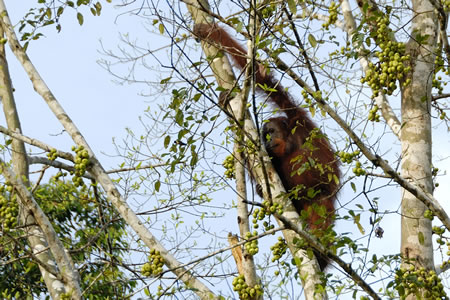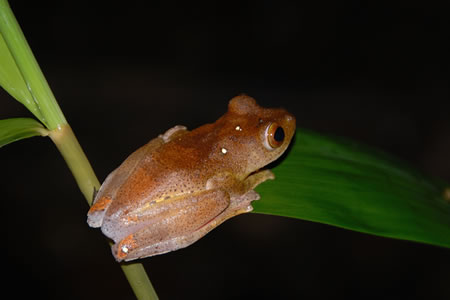

| Uncle Tan’s, jungle paradise or semi-zoo? | |
Kota Kinabalu (Malaysia), June 29th 2009 |
|
Uncle Tan’s (www.uncletan.com) is almost a legend in Sabah. It is the most famous spot in this part of Malaysian Borneo. Travellers come here to experience the real jungle, but especially also to see the Orang-Utans in the wild. The jungle camp is located along the Sungai Kinabatangan River. Most travellers that decide to spend some days in this camp are the so-called backpackers. The accommodation is very basic, which means that the price is also relatively low. At least, it is much cheaper than many of the more high-end resorts that are located more down river. We decided to book also a 3 day/2 night package tour for this famous camp. |
|
 |
|
An Orang-Utan is finding his way up in the tree |
|
It is high season so we had to book several days in advance to be sure that we had a place on the camp. At 1.00 pm on the first day we have to be present at the operations base of Uncle Tan’s, near the city of Sandakan. During the check-in process we have to sign a paper that we understand that the accommodation at the jungle camp is basic and that it is in no-way a resort or spa. After all guests arrived and enjoyed the simple but tasty lunch buffet, we get a briefing about the activities for the next three days. As expected, all guests are backpackers, and together with one other couple we are the oldest persons of the group of in total fifteen people. At 2.30 pm we leave the operations base for the almost two hour journey to the jungle camp. The first hour takes us over a sealed road, but afterwards we turn right to continue the trip over a gravel road. The road is part of a huge network of similar roads that gives access to all areas of a vast palm oil plantation. We saw already during our first bus ride in Borneo, the five hour ride from Semporna to Sandakan, that most of the jungle disappeared for the benefit of palm oil plantations. When you drive through the hills of Sabah and you see for hours and hours only palm oil plantation as far as the horizon, you realise what the dimension of the disaster is that happened here. Unfortunately, Borneo can not be associated anymore with vast and dense jungle, but has ‘developed’ itself to one of the biggest palm oil producers in the world. After a one hour drive through the palm oil plantation we arrive at a jetty at the Sungai Kinabatangan River. We ask ourselves if this is the jetty from where we have to take to boat to the jungle camp, because we didn’t leave the palm oil plantation yet. But when one of the employees of Uncle Tan’s tells us that the jungle camp is only a two minute boat ride from here, we are concerned. Will this be a three day stay in the jungle, or in a palm oil plantation? We step with the whole group in two small boats and before we go to the jungle camp, we will get a short introduction of the ‘jungle’ and hopefully to spot maybe already some wildlife. Within minutes we understand how this ‘jungle’ is set up. Along both sides of the river, a small part of the jungle survived, where all wildlife retreated itself. On some places the number of rows of trees is, without exaggerating, reduced to only one row. Between the trees you see the palm trees of the plantations that lie behind. Soon after, we spot our first wildlife. A group of Proboscis Monkeys sits high in the trees, but it is still easy to see them from the river. After the short boat ride we proceed to the camp. The camp is indeed very basic. The tourists sleep in six wooden huts that can take six persons each. There are three thin two-person mattresses on the floor and to protect you from the mosquitoes, every mattress has a mosquito net. We share our cabin with four other people, a couple from Denmark and two girls from Austria. In the back of the jungle camp is a small building with four toilets. There are no showers, so if we want to wash ourselves we have to retreat to one of the toilets with a bucket of water. The water is by the way brown; it is pumped out of the river. Close to the river is a bigger open construction with picnic tables in it. It is the common area where also the breakfast, lunch and dinner is served. After the dinner buffet, which is again simple but good, we get ready for the first real activity; a night safari by boat. But within ten minutes after we left we have to return to the camp again. It started raining. The rain was so heavy that is was no fun anymore to proceed with the safari. |
|
 |
|
A harlequin frog during the night safari |
|
| The second day of the tour is the only day that you spend entirely in the jungle. We get up at 6.00 am for the morning boat safari that starts at 06.30 am. Again we are shocked by the fact that only a very small part of the jungle survived. The remaining animals have only a limited number of rows of trees left on both sides of the river, which means that the density of animals is high. Without difficulties we see Orang-Utans, Proboscis Monkeys, Borneo Gibbons, Macaques, Otters, and three different species of Hornbills (Wrinkled Hornbill, Oriental Pied Hornbill and the Black Hornbill). After breakfast we have a jungle trekking during which the guide shows us insects and different plants that can be found in the forest. The late afternoon is used for another boat trip, while the evening is used for a great night trekking. We bridge only two hundred metres in two hours, but we see a lot of spectacular animals. We saw among others the Harlequin Tree Frog, colourful insects and two sleeping birds (a Hooded Pitta and a Scarlet-rumped Trogon). We arrive back satisfied at the jungle camp at 11.30 pm.
The last morning of our stay at the camp is used for another boat safari. As during the boat safari of the day before, we see again a lot of animals. Again we are lucky to see Orang-Utans, but we also see a Stork-billed Kingfisher from very close, an Oriental Darter, a White-bellied Sea-Eagle and the fantastic Rhinoceros Hornbills. After we arrived back at the camp, we took breakfast and prepared ourselves fro the journey back to the operations base near Sandakan. At 10.00 am we take the boat back to the jetty, where four jeeps are waiting to take us back to the main sealed road where we have to change to a minivan. With mixed feeling we look back at our stay at the jungle camp of Uncle Tan. On one hand it is a great place to see a huge number of spectacular and sometimes even very rare animals (like the Orang-Utan) in the wild, and just for that reason you should already consider going there. On the other hand is it shocking to see that almost all the jungle disappeared. It is difficult to say that the animals are still really wild, because they are trapped in small pockets of forests that are fenced by the palm oil plantations. There is just nowhere to go for them. How you can describe a visit to Uncle Tan’s best? “Camping in a semi-zoo” is probably the best definition. It is sad but unfortunately true … © copyright - Babakoto.eu / 2009 |
|